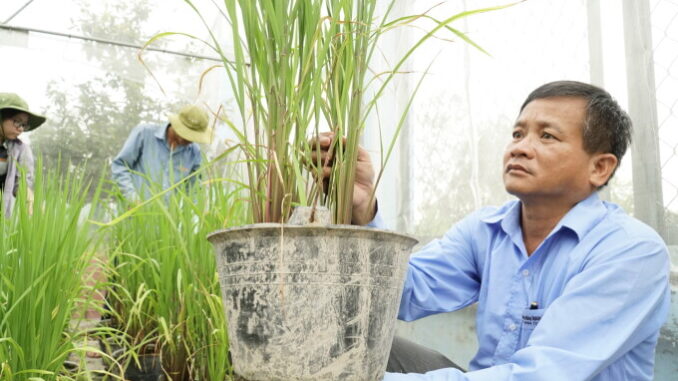
DONG THAP – Over the years, Mr. Nguyen Anh Dung, 52 years old, Dinh An commune, Lap Vo district, has bred many high-value rice varieties to help farmers produce efficiently.
More than 20 years ago, a young man from Dinh An was discharged from the army and returned to the countryside to work in agriculture. Unlike many farmers his age, he was quick-witted and innovative. In 2003, he was sent by the locality to participate in a farmer seed training course (rice production techniques) to guide farmers.
Becoming a “lecturer” for farmers, he became passionate about, tinkering with and breeding new varieties of rice. After many years of farming, he understands each development cycle of rice. However, breeding is not easy for someone who has not been trained in agriculture like him. Breeding requires practitioners to be really passionate and persistent for many years.

“The mother plant’s rice seed blooms 2/3 of the flower, cut off the pollen bag, and take the pollen from the father tree. This step requires the right hand to be precise, the eye to observe carefully. Just a small mistake will damage it,” he said. and said that the initial pollination was only about 20% successful. Toiling all day in the field, in the evening he turned on the lamp to practice “pollinating rice”.
After mastering 70-80%, Mr. Dung faced challenges when the newly planted hybrid seed did not germinate or the vigor was weak, the rice flower failed to bloom… The clumps of rice propagated behind the house kept failing from season to season. another season. “Fortunately, after 9 rice crops, it takes 3 years to produce purebred varieties, exactly as originally intended, but it usually takes 4-5 years,” he said.
Nine years after the “starting business” of rice breeding, Lap Vo farmers collected the first “sweet fruit” which was the LD2012 hybrid from the mother plant, OM 6976 and the father plant IR 50404. good pest, long-grain, sticky rice.
Continuing to sow for the next crop, in 2015, Mr. Dung discovered a special rice plant, with a natural pineapple aroma, and a growth period of about 90 days. The new red rice seed was named Ngoc Do with pineapple flavor and registered for protection.
He used his own way to promote the new breed. Just finished grinding rice, he brought gifts from motorbike taxi drivers, people from other regions and countries, leaders of communes, districts, provinces… Persevering with the motto “give it away, you will receive it back”, after 3 months he has his first order. At first, it was only a few bushels and then gradually increased to ten tons of rice per crop.

An enterprise saw that the pineapple-scented red jade has commercial potential, so he offered to “buy it out” for 4 billion dongs, but he refused. Because the father of the Red Jade and Pineapple variety thought that if he sold himself, he would have more capital, but the farmers in Lap Vo did not benefit. He suggested that the enterprise sign an exclusive contract of consumption, while he would gather farmers to produce rice.
The proposal was approved by the business, signed to buy 8,000 VND per kg, 1,000-3,000 VND/kg higher than other rice varieties, in which the seed royalties are 500 VND per kg. During the four years from 2016 to 2019, the rice area covered is up to 500 hectares per year. Farmers who co-produce with him earn an additional profit of 5 million VND per hectare (compared to other rice varieties), not afraid of precarious output.
After the Pineapple Red Jade, he continued to successfully cross-breed ND3, LD2012-1, and a few other varieties that are registered for protection.
In 2012, with some farmers established Dinh An Agricultural Cooperative, he was assigned the role of director. Currently, the varieties of rice he bred each year provide about one hundred tons to the market. Compared to a company specializing in providing seeds, that number is not much, but the scale of a cooperative is not small.
For nearly 20 years as a farmer, he was recognized by the IRRI International Rice Research Institute as “a farmer conserving the biodiversity of rice varieties in the Mekong Delta”. The contests of good rice farmers in the Western region, smart rice farming, and climate change adaptation, he won the first prize; recognized as “farmer’s scientist” 2 years ago.
Recently, he was honored by the Central Vietnam Farmers’ Association as the best farmer of the year.
Chairman of the Dong Thap Farmers’ Association Nguyen Van Nguyen said that Mr. Dung is a typical farmer of the province in the spirit of learning, working hard to find new varieties. “When facing difficulties, Dung is not discouraged, determined to do it to the end,” Nguyen said. It is valuable that after successfully creating a new variety, Mr. Dung actively seeks out the market, rather than waiting for businesses to come and buy, the purpose is to help farmers benefit the most from the rice variety he has created. Follow vnexpress
